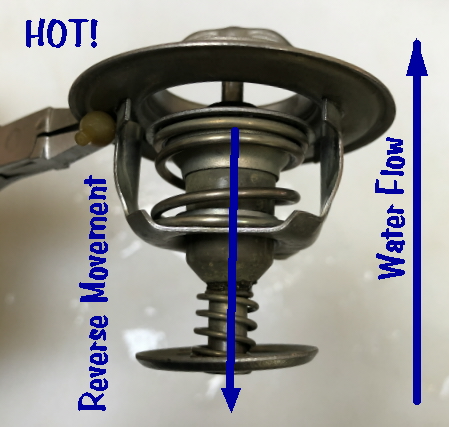

By the
1960's, engines were producing more power and running more accessories.
And emissions became an issue. This created the need for better cooling.
One of the keys to better cooling was the development of the wax motor/reverse
poppet thermostat. Let's see how these work.
The core of the wax thermostat is the motor. Unlike the bellows thermostat, which used an expandable metal bellows filled with alcohol, the wax thermostat uses a rigid brass or copper cup filled with solid wax. Waxes can be blended with any desired temperature range and the motor sized to produce any needed level of force, opening point, and hysteresis. When heated, the wax melts and rapidly expands, acting against a rubber diaphragm, which in turn tranmits force to the pin. The pin is pushed out of the cup and reacts against the pin retainer, forcing the entire wax motor backwards. Wax motors in automotive thermostats typically have a stroke of 8mm.
The main poppet is permanently attached to the motor, so as the motor moves backwards, the flow path to the radiator is opened. The thermostat in the illustration is a bypass thermostat, which has poppets on either end. The bypass poppet closes the bypass passage as the main passage is opened (more about bypass systems in the next chapter.) Wax motors have several advantages over bellows. The cup is perfectly rigid, and cannot be compressed. The wax is incompressible as well, whether in solid or liquid form. And since the poppet moves backwards against the direction of flow, there is no longer a problem of the poppet lifting in response to inertial forces. So pressure limitations are largely eliminated, allowing more aggressive water pumps and radiator caps to be used. This results in better water circulation and higher boiling points. Boiling
Point Elevation vs Pressure
This Youtube video shows how wax thermostats are manufacured: I would be remiss to end this story without a little history. The wax thermostat was invented by Sergius Vernet. Vernet was born in Brooklyn and trained as an engineer at Pratt. Around 1930, he set up what we would now call an incubator company under the asupices of Antioch College in Yellow Springs, Ohio. Vernet was a prolific inventor who already had a long list of patents by 1930, including the reciprocating windshield wiper mechanism. As Vernay Patent Company, he filed his most important patent in 1934 (US Patent 2115501.) Most of the elements were there, although his selection of paradichlorobenzene (mothballs) as the powering substance seems a bit humorous in retrospect. While Vernet primarily operated as a patent licensor, he also spun off several operating companies in the area of thermal controls and rubber products. Several of these spinoffs survive to this day...Vernay Laboratories, which produces a broad range of flow control products, Rostra Vernatherm, which produces thermal controls for heavy duty applications, and Vernet (of France), which produces thermostats. "Vernatherm" has become a generic term for oil cooler thermal valves. While Vernatherm produced oil cooler thermostats during WWII, automotive uses for wax motors seem to have come much later. The earliest example I've found of a wax thermostat for automotive applications is this Fulton-Sylphon thermostat from a '55 Packard. The design still pretty close to Vernet's original 1934 patent. It's probable that the expiration of the patent unleashed a flood of development:
<Bellows Thermostats Main Page Air Venting> Copyright©2019 CoolCat Express Corp. |